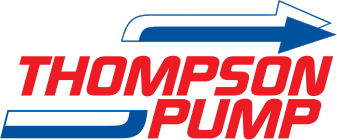Thompson Midwest Faces Application Challenges
Thompson Midwest Dewaters 23’ Beneath River Bottom:
A local contractor needed to install a collection chamber at the base of a river 23’ below the riverbed. The contractor consulted Thompson Midwest after having unsuccessful responses from two other local dewatering contractors. After reviewing the plans and visiting the jobsite, Thompson Midwest installed the wellpoint system using the punch and casing method of wellpoint installation in the shape of a long horseshoe to adequately remove the groundwater for the installation of the collection chamber. The pumping was done by Thompson’s 12” Rotary Wellpoint Pump, which has the ability to work on systems up to 1,400’ long, allowing for significant cost savings for the contractor. Thompson Midwest also supplied all of the required wellpoint accessories for the application. Thompson Pump’s founder, George A. Thompson invented the Rotary Wellpoint Pump and the company has been using this type of dewatering for more than 30 years.
Midland Bypass:
The Midland Bypass required a pump system that could handle flows of up to 2,000 gpm. This was the easy part of the application. The location of the bypass proved to be a challenge. The sewer manhole was located in the middle of a busy intersection that could not be shutdown while the bypass was operational. Another obstacle was that the bypass was located in front of the Mid-Michigan Medical Center that had two entrance points. The road had to allow the normal traffic and emergency vehicles to enter and exit the hospital. Thompson Midwest used two Thompson 6-inch Solids Handling High Pressure Pumps that fed into a 12” road ramp. This allowed the discharge flows to continue uninterrupted to the established discharge point 2,000’ away, using Thompson Galvanized Pipe.
Thompson Provides Added Security:
Crews at the Miller Road Pump Station were at work on an installation of 30” hydraulic pumps. Prior to the set up of the hydraulic pumps, the last working pump at the Miller Road Pump Station failed. Thompson Midwest responded quickly by providing two 12” Solids Handling High Pressure Pumps and one 8” Hydraulically Driven Submersible Trash Pump. These pumps were used in the event of a heavy rainfall and to help regulate the surge in flow. The 12” High Pressure Pump is capable of flows to 7,500 gallons per minute and the 8” Hydraulic Submersible is capable of flows to 2,200 gallons per minute.
Thompson Midwest Utilizes Wellpoints in Application:
Wellpointing is a proven dewatering method and rarely is used in the upper Midwest. Thompson Midwest has established itself as an effective front line supplier for the Michigan market, and has embraced this dewatering method, thereby offering its customers more dewatering options. While different methods of underground dewatering are available, it depends on the soil conditions. On this application, highly pressurized water was supplied through a hose and into a 6” diameter casing that was jetted into the ground with the aid of a crane. This creates a filter pack around the point, allowing for maximum flow. The pumping is done by Thompson’s 12” Rotary Wellpoint Pumps. One pump has the ability to work on systems up to 1400’ long, allowing for significant cost savings for the contractor. Thompson has been using this method for over 30 years with great success.
Thompson Midwest Dewaters Tunnel Segments:
Thompson Midwest, working with engineers from Traylor Brothers, devised a system that would create vacuum to remove the water on the backside of their segments, allowing for Traylor to grout effectively. A Thompson 6-inch Dry Prime Vacuum-Assisted Pump unit powered by a 30 hp motor was installed on the mining machine for this application. Special 2.5” wellpoints were fabricated by Thompson Midwest to maximize the efficiency of the dewatering process.
